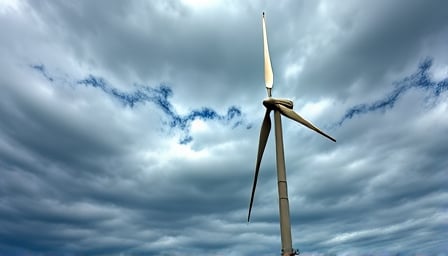Orsted AS Faces Volatile Share Price Amidst Regulatory and Market Uncertainties
Orsted AS, a global leader in offshore wind development, has seen its share price swing sharply in recent trading sessions. While analysts continue to project a possible upside, the company’s valuation has been tempered by a series of external shocks, including the cancellation of a Rhode Island wind project and the Federal Reserve’s interest‑rate cut. These events highlight the complex interplay between market sentiment, regulatory frameworks, and the technical realities of modern power systems.
Impact of the Rhode Island Project Cancellation
The U.S. government’s decision to suspend the offshore wind project off Rhode Island—an initiative that would have added 500 MW to the local grid—has raised concerns about the regulatory risk profile of offshore developers. Orsted’s rebuttal, citing “factually incorrect” grounds, underscores the heightened scrutiny of environmental assessments and permitting processes in the United States. From an engineering perspective, the loss of this project not only reduces immediate capacity but also delays the integration of a critical renewable resource that would have contributed to grid resilience during seasonal peaks.
Grid Stability and Renewable Integration Challenges
Modern power grids must accommodate the intermittency of wind and solar resources while preserving voltage stability and frequency regulation. The integration of large offshore wind farms introduces several technical challenges:
- Power Flow Variability: Offshore turbines exhibit rapid power output swings due to wind shear and turbulence. These fluctuations can induce reactive power demands that strain existing transmission corridors.
- Grid Code Compliance: Utility interconnection standards now require active voltage support, fault‑ride‑through capabilities, and grid‑forming converter functionalities—features that increase the cost of offshore wind plants but are essential for maintaining system inertia.
- Dynamic Stability: With high penetration of inverter‑based resources, the traditional synchronous inertia supplied by fossil generators diminishes, necessitating synthetic inertia solutions or fast‑frequency response services.
Orsted’s projects frequently incorporate advanced power electronics and grid‑forming converters, positioning the company to meet evolving grid codes. However, the cost premium associated with these technologies contributes to higher project CAPEX and, consequently, impacts investor expectations.
Infrastructure Investment Requirements
The continued expansion of offshore wind capacity requires significant upgrades to the transmission network, including:
- High‑Voltage Direct Current (HVDC) Corridors: Offshore wind farms are typically connected to shore via HVDC links, which reduce transmission losses over long distances and support cross‑border interconnections.
- Sub‑station Enhancements: Upgrades to step‑up transformers and switchgear are necessary to handle higher power flows and to provide voltage support functions.
- Grid Management Systems: Smart grid technologies—such as advanced SCADA, real‑time monitoring, and predictive analytics—enable utilities to better coordinate distributed generation and demand response programs.
Investment in these areas is critical to avoid bottlenecks that could undermine the economic viability of new wind projects. Regulatory bodies in many jurisdictions are beginning to incorporate grid upgrade costs into project permitting and tariff structures, potentially altering the revenue model for developers.
Regulatory Frameworks and Rate Structures
The U.S. and European regulatory landscapes are evolving to accommodate the growing share of renewables:
- Transmission Tariffs: Independent system operators (ISOs) are implementing transmission charges that reflect the cost of network upgrades, thereby passing infrastructure expenses to consumers. For Orsted, this means that project economics are increasingly sensitive to tariff designs.
- Renewable Portfolio Standards (RPS): States with aggressive RPS mandates often provide incentives for offshore wind, but the level of support varies widely. In regions where the RPS is coupled with a net‑metering regime, developers can recover a larger portion of their investment through utility bills.
- Grid Code Reforms: The European Network Code for Transmission System Operators (TSO) now mandates grid‑forming capabilities for inverter‑based resources, ensuring system stability but raising installation costs.
These regulatory dynamics influence both the feasibility of new projects and the strategic decisions of investors. As the market moves towards more stringent grid codes, Orsted’s early adoption of compliant technology may provide a competitive edge, albeit at a higher initial cost.
Economic Impacts of Utility Modernization
Utility modernization encompasses the deployment of digital controls, energy storage, and flexible generation resources. The economic implications are multifold:
- Capital Expenditure (CAPEX): Modernization projects typically require significant upfront investment, yet they reduce long‑term operational costs through improved efficiency and reduced outage risk.
- Ratepayer Costs: Consumers may experience higher rates in the short term to recover investment costs; however, the long‑term benefit includes reduced peak demand and lower wholesale electricity prices.
- Job Creation: The construction and operation of new HVDC links and substations generate skilled employment opportunities, contributing to local economies.
Orsted’s portfolio of offshore wind projects inherently aligns with the broader trend toward decarbonization, yet the financial performance of each project is contingent on the balance between investment costs, regulatory support, and market pricing.
Stock Market Response and Investor Considerations
The Federal Reserve’s recent 25‑basis‑point rate cut has introduced a degree of uncertainty into the equities market. While lower interest rates generally support higher asset valuations, the volatility in Orsted’s share price suggests that investors are factoring in:
- Regulatory Risks: The Rhode Island project cancellation serves as a reminder of the political and regulatory risks associated with large‑scale renewable projects.
- Technological Costs: The need for advanced grid‑forming equipment and HVDC infrastructure raises CAPEX, potentially compressing profit margins.
- Market Sentiment: The “buy” recommendation from UBS, despite a lowered price target, reflects confidence in long‑term growth but acknowledges current market volatility.
In light of these factors, prudent investors should assess the risk profile of renewable developers against the backdrop of grid stability challenges and evolving regulatory frameworks. The technical complexities of modern power systems—particularly the integration of high‑penetration offshore wind—necessitate a nuanced understanding of both engineering realities and financial implications.
